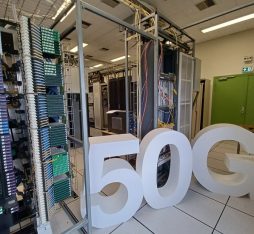• Thoroughly tested, both in the lab and live environments, this new mobile access network model has already demonstrated its relevance and efficiency.
uses a new architectural logic for RAN (Radio Access Networks), based on disaggregation, i.e. virtualised RAN functions can be deployed on different hardware (software is separated from hardware) allowing greater flexibility, scalability and profitability. This model promotes multi-vendor design and deployment, with key RAN components from different providers, thereby diversifying the RAN vendor ecosystem and driving renewed competition. Telecom carriers advocate Open RAN to avoid dependence on a single equipment manufacturer for other assets.
- The use of RAN application servers—rather than the current approach of relying on dedicated hardware—paves the way for economies of scale and endless innovations in this area.
- The multi-vendor approach also allows the components of the deployed solution to be changed individually rather than en masse.
- Virtualisation makes it easy to automate draining and/or repetitive operational tasks.
- Network configuration can be adapted and optimised—based on usage—via the RAN controller thanks to artificial intelligence and machine learning.
Open RAN takes its big commercial leap: A pilot in rural Romania soon to be followed by others in urban areas, with other Orange Group subsidiaries.
Open RAN is gaining traction
Orange is one of the most committed players driving this new approach. As a founding member of the O-RAN alliance, through which carriers and providers develop Open RAN specifications, the Group launched France’s first Open RAN integration centre in 2021. The goal of the work done here is to ensure the reliability and full development of this new solution and to support new RAN technology vendors such as Mavenir, particularly via its OTIC (Open Testing and Integration Centre) or as part of the Pikeo project.
Orange also works with traditional RAN equipment manufacturers. Nokia, Ericsson and Samsung are working in tandem with server and chipset providers to increase the capacity and energy efficiency of their Open RAN solutions. Orange verifies this progress in its laboratory, supporting the evolution of Open RAN software and its underlying hardware.
In the global telco ecosystem, Open RAN is becoming a reality as it prepares to pass reliability testing and industrialisation milestones. In late 2023, AT&T announced a deal with Ericsson, Dell, Fujitsu and Intel, paving the way for large-scale deployment in the United States. Traditional RAN players take a favourable view of the cloud and Open RAN, meaning carriers are now guaranteed solutions without loss of reliability or functionality compared to traditional RAN.
RAN that is open… and virtualised
are also increasingly keen to see Open RAN development and deployment, especially for B2B enterprise use cases. “The core of the network, the access network manager and the CU (Centralised Unit) function—whose role is to manage the upper layers, i.e. radio resources, mobility, service quality, user data and so on—are network functions that can be deployed on any type of infrastructure, and are naturally compatible with hyperscaler public clouds,” explained Christian Gallard, Head of Orange Open RAN Integration Centre, and Miloud Abdi, O-RAN Network Architect & Transversal Project Manager. “Radio communication requires substantial real-time processing by the intelligent part of the RAN (the DU, or Distributed Unit, in Open RAN models), which requires suitable hardware for the RAN.” Hyperscalers offer tailored solutions for mobile networks, and especially DUs, such as Amazon EKS (Amazon Elastic Kubernetes Service) from AWS (Amazon Web Services) and its on-premises Amazon EKS-A (Amazon EKS Anywhere) option. In 2023, Orange included Open RAN at the heart of the experimental, virtualised and automated 5G SA network, built with AWS, Mavenir and Dell. This provided some promising pointers: “The core network, the CU and the RAN manager are deployed via the AWS public cloud and the DU is deployed via the EKS-A infrastructure hosted on a Dell server at Orange’s premises. This testing allowed us to demonstrate the hugely flexible nature of this solution, which can be rolled out on demand to a customer in under two hours. The agility and flexibility of the Open RAN component provided by Mavenir in terms of portability across the different types of infrastructures tested also highlight its uniqueness.”
Reinventing the operational model
Orange is currently laboratory testing Nokia’s cloud RAN solution, after evaluating solutions by Samsung and Ericsson last year. Each solution is based on a different configuration (called a “blueprint”). Each involves running software on an ordinary server, and is therefore deployable on any other type of server. For example, Samsung has already deployed this model using Dell servers and a Windriver infrastructure, while Ericsson—having made several solutions available to its customers—opted for HPE platforms (Racks) during tests with Orange to ensure that its cloud RAN solution could support RedHat OpenShift functionalities. Reference blueprints avoid the complex options made possible by the multiplicity of stakeholders and configurations inherent to the open approach. “We find a software partner for implementing the RAN, another for servers, another for dedicated RAN accelerator cards for the most computationally intensive functions, another for radio modules, and so on. This diversity complicates component integration. The question is how to manage all these providers on an operational level. Initially, Orange would have to deploy solutions that are already pre-integrated by RAN vendors; then, with greater product maturity, integration could be supported either by a third-party player, usually called a system integrator, or, in part, by Orange itself.” Field testing gives us greater clarity with which to refine this new model.
Romanian Pilot
Since 2023, Orange has been running a pilot in Romania in partnership with Vodafone, based on a Samsung Open RAN solution deployed on a limited scope (ten 2G and 4G radio sites in rural areas, in RAN Sharing mode). This foundational deployment ensures team upskilling and checks performance maturity (throughput, capacity, latency etc.) and energy consumption, comparing Open RAN to classic RAN.
The indicators monitored have confirmed equivalent performance and stability to traditional RAN. Radio energy consumption is also already on a par. Meanwhile, server energy efficiency is able to benefit from constant improvements through advances in materials and software.
Feedback from the pilot :
Open RAN features in Orange OpenTech 2024, with a demo highlighting the performance levels achieved by Open RAN vs classic RAN as well as the latest advances in automation. The first feedback from the Open RAN Sharing pilot in Romania will also be shared.











